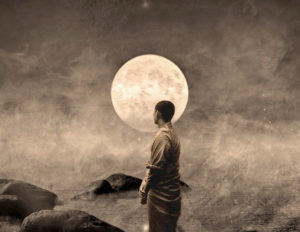The sutras build on each other so we must review sutras I.1 and I.2 in order to better understand 3 and 4. Sutra I.1 says “and now… yoga” suggesting that we’ve likely tried many other pathways to find ourselves and all have eventually fallen short. So now, we turn inward and begin the path of yoga. Sutra I.2 says, “yoga is both the process of settling the compulsive mind, and the state we enter when the compulsive mind becomes conscious”.
 Sutras I.3 and I.4 are giving us the contrast between living in a conscious mind versus a compulsive mind. Sutra I.3 says, “Then the seer (conscious Self) abides in their own nature.” Here Patanjali is reminding us that we are the thinker of thoughts, not the thoughts themselves. Abiding in our own nature means we understand that we are the story teller of our lives, we are not locked into the story as it is. He is encouraging us to make space between our consciousness and the stream of thoughts moving through our minds. When we can watch our thoughts with quiet detachment, we are less identified with them and more masterful in redirecting them. It is only with this healthy detachment that we can gain mastery over our thoughts and use them as powerful tools. Without this healthy distance, it feels like our thoughts are thinking us; owning us. We become slaves to compulsive thoughts. The mind is a tool designed to assist a soul in expressing, exploring and expanding. As with any tool, we want to use it skillfully and deliberately. Without skill and deliberation, a tool can become a dangerous weapon. Part of mastery of the mind includes being able to “set it down” when we are not using it skillfully. If you were a chef using kitchen knives to prepare food, would you want those knives dancing around compulsively even when you are not cooking? This is the Nirodaha (stilling) of the Chittas Vritti (mental compulsions) Patanjali speaks of in Sutra I.2
Sutras I.3 and I.4 are giving us the contrast between living in a conscious mind versus a compulsive mind. Sutra I.3 says, “Then the seer (conscious Self) abides in their own nature.” Here Patanjali is reminding us that we are the thinker of thoughts, not the thoughts themselves. Abiding in our own nature means we understand that we are the story teller of our lives, we are not locked into the story as it is. He is encouraging us to make space between our consciousness and the stream of thoughts moving through our minds. When we can watch our thoughts with quiet detachment, we are less identified with them and more masterful in redirecting them. It is only with this healthy detachment that we can gain mastery over our thoughts and use them as powerful tools. Without this healthy distance, it feels like our thoughts are thinking us; owning us. We become slaves to compulsive thoughts. The mind is a tool designed to assist a soul in expressing, exploring and expanding. As with any tool, we want to use it skillfully and deliberately. Without skill and deliberation, a tool can become a dangerous weapon. Part of mastery of the mind includes being able to “set it down” when we are not using it skillfully. If you were a chef using kitchen knives to prepare food, would you want those knives dancing around compulsively even when you are not cooking? This is the Nirodaha (stilling) of the Chittas Vritti (mental compulsions) Patanjali speaks of in Sutra I.2
 Now Sutra I.4 gives us the flip side of I.3. Here Patanjali says, “Without the stillness, the Self appears to assume the forms of the mental flux”. He is telling us that we can get so lost in our unchecked mind flow that we forget that we are the thinker. We can become such a psychological mess and get so lost in mental torment that we forget that we created our own torment. As Byron Katie says, “We can only live the stories we tell about ourselves, others and the world”. The problem is this: we forget that we are the story teller, not the story. As the story teller, we are empowered to change the story. If we forget our power as the story teller, we get stuck in the story like a bad nightmare.
Now Sutra I.4 gives us the flip side of I.3. Here Patanjali says, “Without the stillness, the Self appears to assume the forms of the mental flux”. He is telling us that we can get so lost in our unchecked mind flow that we forget that we are the thinker. We can become such a psychological mess and get so lost in mental torment that we forget that we created our own torment. As Byron Katie says, “We can only live the stories we tell about ourselves, others and the world”. The problem is this: we forget that we are the story teller, not the story. As the story teller, we are empowered to change the story. If we forget our power as the story teller, we get stuck in the story like a bad nightmare.
 The take away from these first four sutras, might be this: Get interested in your inner atmosphere. Witness the flux of the mind with inner stillness until it grows quiet under you noble gaze; in other words, meditate regularly. Once the mind becomes shy and quiet from your consistent steady observation, then reclaim it as your powerful tool of creation. Do this often to keep a loving command of your thoughts. Know yourself as the story teller; not the story.
The take away from these first four sutras, might be this: Get interested in your inner atmosphere. Witness the flux of the mind with inner stillness until it grows quiet under you noble gaze; in other words, meditate regularly. Once the mind becomes shy and quiet from your consistent steady observation, then reclaim it as your powerful tool of creation. Do this often to keep a loving command of your thoughts. Know yourself as the story teller; not the story.
